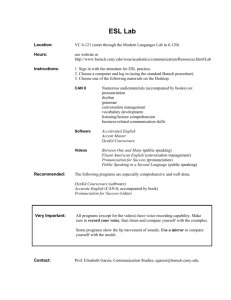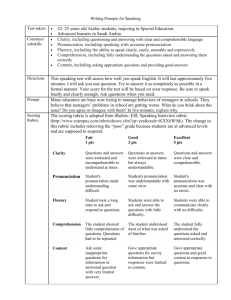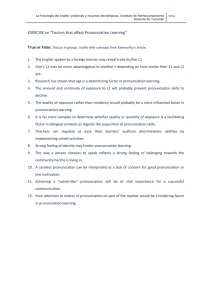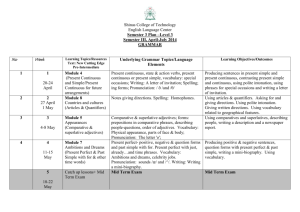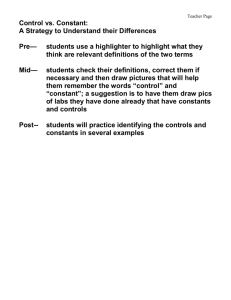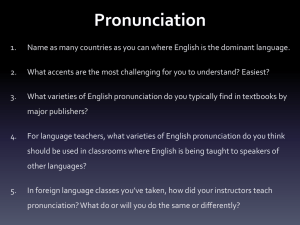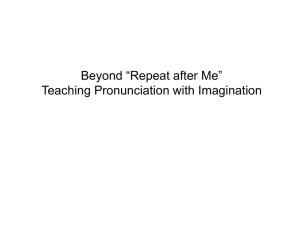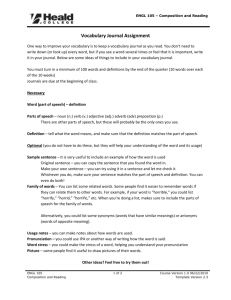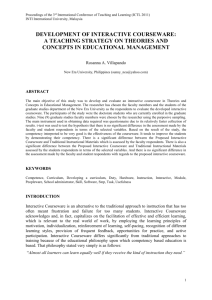Teaching Pronunciation and Intonation with Computer Technology
advertisement
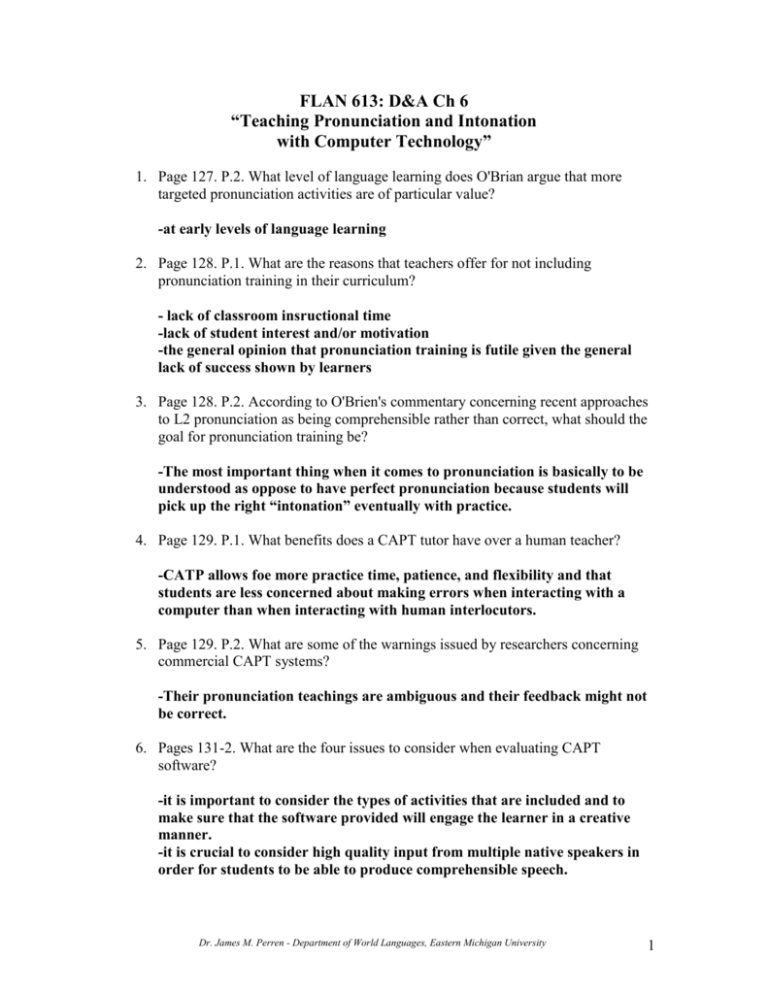
FLAN 613: D&A Ch 6 “Teaching Pronunciation and Intonation with Computer Technology” 1. Page 127. P.2. What level of language learning does O'Brian argue that more targeted pronunciation activities are of particular value? -at early levels of language learning 2. Page 128. P.1. What are the reasons that teachers offer for not including pronunciation training in their curriculum? - lack of classroom insructional time -lack of student interest and/or motivation -the general opinion that pronunciation training is futile given the general lack of success shown by learners 3. Page 128. P.2. According to O'Brien's commentary concerning recent approaches to L2 pronunciation as being comprehensible rather than correct, what should the goal for pronunciation training be? -The most important thing when it comes to pronunciation is basically to be understood as oppose to have perfect pronunciation because students will pick up the right “intonation” eventually with practice. 4. Page 129. P.1. What benefits does a CAPT tutor have over a human teacher? -CATP allows foe more practice time, patience, and flexibility and that students are less concerned about making errors when interacting with a computer than when interacting with human interlocutors. 5. Page 129. P.2. What are some of the warnings issued by researchers concerning commercial CAPT systems? -Their pronunciation teachings are ambiguous and their feedback might not be correct. 6. Pages 131-2. What are the four issues to consider when evaluating CAPT software? -it is important to consider the types of activities that are included and to make sure that the software provided will engage the learner in a creative manner. -it is crucial to consider high quality input from multiple native speakers in order for students to be able to produce comprehensible speech. Dr. James M. Perren - Department of World Languages, Eastern Michigan University 1 -the quality of assessment of the learner's speech because it involves checking the student's errors such as diagnosing intelligibility instead of native-like pronunciation -it is important for students to understand why they receive the scores they do so they know where they need to improve. 7. Page 131. P.3. What are the three categories of CALL-mediated curricula-based software (courseware)? -1. Basic Pronunciation courseware that relies on the computer for speech recording and on the student for the analysis of the pronunciation. -2. Courseware that makes use of automatic speech recognition (ASR) technology for the analysis of learner errors. -3. Visualization courseware that provides learners with images to assist them in analyzing their speech based on computerized phonetic analyses. 8. Pages 131-2. What are some of the strengths and weaknesses of basic pronunciation training courseware? Provide an example of both. 9. Page 132. P.2. According to O'Brien, to what are the types of activities in the most basic pronunciation courseware packages often limited to? -to imitation of native speaker modela and minimal pair exercise that students are expected to judge on their own 10. Page 132. P.5. What is automatic speech recognition (ASR) software, why do native speakers use it, and why do researchers have difficulty working with it? -Automatic speech recognition (ASR) software is software that captures, recognizes and reacts to human speech. -Researchers have difficulty working with it because of the wide variation in native speaker pronunciations. While correct recognition of native speakers' productions is challenging enough, most systems have great difficulty correctly interpreting the speech variations and accents of non-native speakers. 11. Page 133. P.2. What are some of the most successful uses of (ASR) technology described in the Eskenazi (1999b) study? -At that moment in the activities that constrain the learner’s answer to one of limited number of possible answers Dr. James M. Perren - Department of World Languages, Eastern Michigan University 2 12. Page 133. P.3. What does the ASR courseware, TeLL Me More (designed for multiple languages) allow students to do? -TeLL Me More allows students to choose from among three possible answers. It also gives students the task of correctly ordering jumbled sentences. O’Brien emphasized on learner autonomy when using “TeLL Me More”. 13. Page 134. P1. With what do many of the ASR technology products provide students? -variety of native speakers of the target language 14. Page 134. P2. What is one of the most beneficial aspects of ASR-based courseware? Give an example of the type of feedback given to students. -One of the most beneficial aspects of ASR - based courseware is its assessment capabilities. It allows for an accurate diagnosis of learner errors based on the intelligibility of the input speech. -(example) if the program doesn't understand what the student has said it will let them know by saying "I don't understand you"; this will make the student repeat his/her answer and at the same time practice/correct their pronunciation. 15. Page 134. P3. Why is learner autonomy limited with ASR technology and which courseware package provides contradictory evidence to this effect? -Learners autonomy is limited when students make use of ASR courseware due to the fact that only preprogrammed utterance may be evaluated. -Tell Me More, which gives students the task of correctly ordering jumbled sentences. 16. Page 134. P4. Through what means do visualization techniques allow learners to compare their L2 pronunciation to native speaker norms? -pitch contours which help students to improve intonational patterns in the L2, spectrograms which teach students about segmental aspects such as vowel production, aspiration and voicing in the L2, wave forms and notations relating to stress and rhythm. 17. Page 136. P2. On what does the effectiveness of visualization software depend? -Visualization software gives teachers of any language space to create activities for their students and satisfy their needs and their students' need. Dr. James M. Perren - Department of World Languages, Eastern Michigan University 3 18. Page 138. P1. To what does the effectiveness of visualization software depend and according to O'Brien, what types of students benefit from these software applications? -The effectiveness of these programs depends primarily on the students’ ability to interpret the image created by the software. 19. Page 138-9. What are some of the advantages and disadvantages of visualization courseware? -The feedback provide to learners is most affective aspect of visualization courseware, although its effectiveness depends essentially on the case of interpretation as well as on the tips the students are given for improving their pronunciation. 20. Page 140-1. What are the three main issues outlined in the future of CAPT research? -Arises in the creation of software for nearly very language, and that is the role of dialects and multiple standers for language. -ASR, which clearly holds promise, is currently less powerful than many expect it to be. -Disconnect that exist between sound communicative classroom pedagogy and the often technical nature of pronunciation training. Dr. James M. Perren - Department of World Languages, Eastern Michigan University 4


